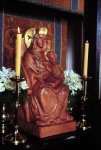
|
The Cell of Our Lady of Walsingham |
|
The Cell of Our Lady of Walsingham at St Peter's is associated with the Society of the Holy House of Our Lady of Walsingham in Norfolk, England. In 1061 the Lady Richeldis, the Saxon Lady of the Manor of Walsingham, had a vision of the Blessed Virgin Mary. As a result of this vision, she had built a replica of the House of the Holy Family at Nazareth. At the site of the house in Walsingham there was also a Holy Well. The shrine became known as England's Nazareth and became a major place of pilgrimage for 500 years, second only to Canterbury. Augustinians and Franciscans established a priory church. In 1538, during the reign of Henry VIII, the shrine was destroyed and for the next 400 years Walsingham reverted to quiet village life. In the 1920's Fr Hope Patten, the parish priest of the parish church of St Mary's in Walsingham, re-established the shrine and once again Walsingham became a place of pilgrimage. The present shrine was completed in 1932 and, on October 15th, the statue of Our Lady of Walsingham was translated from St Mary's to the Holy House which, since that time, has grown as a place of pilgrimage. The shrine focuses on the Incarnation—the mystery of the life, death and resurrection of Jesus Christ. In a constantly changing world, Walsingham speaks about the eternal and permanent things which God reveals to us in Jesus Christ. At Walsingham there is a great work of prayer. Prayers are said at the shrine for people everywhere; for pilgrims who bring their intercessions, as well as for those who write letters from all parts of the world. At St Peter's, the members of the Cell of Our Lady of Walsingham attend a special mass and offer prayers for those in need, particularly those who ask for our love and prayers in the book in the Lady Chapel. Members also take the names of those who ask for our prayers, and remember them in their personal prayers. A mass in honour of Our Lady of Walsingham and for the Cell of Our Lady of Walsingham and St Peter is offered at 6.30 p.m. on the third Sunday of the month, following Evensong and Benediction. This mass is followed by a shared supper. In addition, the Rosary is said each Saturday morning following the 9.00 am Mass. The Cell of Our Lady of Walsingham and St Peter is a group of people who try to serve God through prayer and by reaching out to help others. You are invited to join our prayers and to become a member of the Cell of Our Lady of Walsingham; we would be pleased to welcome you.
Liz Prideaux — Secretary (Phone: 9662 2391)
The Statue of Our Lady of WalsinghamThe statue is in the direct tradition of the great theological icons of Our Lord's Mother. She is enthroned and crowned, drawing attention to the Holy Child sitting on her knee. Her right hand holds a lily sceptre, emblem of her virginal purity. Her feet rest upon a "toadstone" symbolizing the uncleanness of evil. The throne is adorned with two pillars, encircled by bands, three on one side and four on the other, representing the Seven Sacraments, and the top of the back-piece is rounded like a rainbow. Her Divine Son, with a cruciform halo, clasps in his left hand the Book of the Gospels, signifying that the Word was made Flesh and dwelt among us. His right hand is stretched out in protection and blessing. Top | Parish Groups | St Peter's Home
|